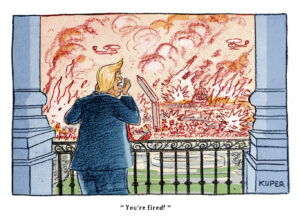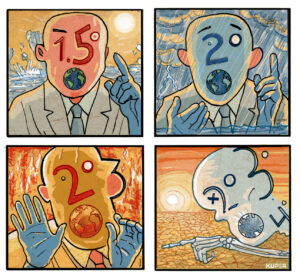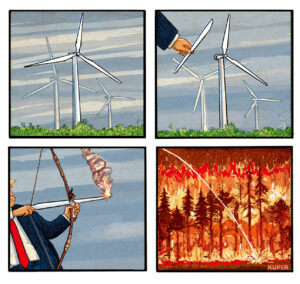The Climate Benefits of NYC’s Hard-Won Congestion Pricing Plan
Driving into lower Manhattan is now more expensive, but the toll promises cleaner air, safer streets and improved subways. (Anadolu / Getty Images via Grist)
(Anadolu / Getty Images via Grist)
This story was originally published by Grist. Sign up for Grist’s weekly newsletter here.
After months — and, for some, years — of anticipation, congestion pricing is live in New York City.
The controversial policy, which essentially makes it more expensive to drive into the busiest part of Manhattan, has been floated since the 1970s as a way to reduce traffic and raise money for the city’s Metropolitan Transportation Authority, which runs the city’s subways and buses. But it wasn’t until 2017 that it seemed like it might finally catch on.
Still, getting it implemented has been an uphill battle. Last summer, New York Gov. Kathy Hochul abruptly paused a carefully crafted plan that would have implemented $15 tolls on drivers heading into Manhattan below 60th Street a mere 25 days before the plan would have gone into effect. Months later, in November, she said she would unpause the plan with lower tolls: $9 for passenger vehicles during peak hours and $2.25 during off-peak. After all the hubbub, New York City made history just after midnight on Jan. 5, when the cameras used to enforce the tolls were turned on.
With this move, New York City becomes the first U.S. city to experiment with congestion pricing tolls, and joins a small cohort of other major cities — London, Stockholm and Singapore — trying to disincentivize driving in order to unlock safer streets and a host of other environmental benefits.
New York City becomes the first U.S. city to experiment with congestion pricing tolls.
Environmental and public transit advocates praise congestion pricing because it pushes drivers to reconsider whether getting behind the wheel is really the easiest way to get around the city. With fewer cars on the road, congestion pricing promises shorter commute times for those who do drive — and better public transit options, since the money raised by congestion pricing will fund capital improvements by the Metropolitan Transportation Authority (MTA).
But the policy has not been without its naysayers. One New York City councilmember — Republican Vickie Paladino — appeared to encourage her followers on X to damage the tolling cameras with lasers. Congestion pricing detractors say that tolls are burdensome. Of course, in some way, that is the point: to make driving slightly less appealing and incentivize alternative modes of transportation.
Proponents say the costs are worthwhile because they fund meaningful improvements to New Yorkers’ lives — like safer streets and cleaner air.
“At this point, across much of the country, cars are so ingrained into American culture that we don’t always think of them as environmental hazards, but of course they are,” said Alexa Sledge, director of communications for Transportation Alternatives, an advocacy group focused on street safety in New York City. “So a major goal of our climate policy has to be getting people out of cars and on public transit, onto buses, onto bikes, onto trips on foot.” Lower carbon-intensive modes of transit, she says, are “always going to be substantially more environmentally friendly.”
One of the main selling points of congestion pricing, besides reducing traffic, is improving air quality. Fewer cars on the road means fewer cars emitting exhaust in the nation’s most densely populated city — and less traffic also means that less time spent idling.
An environmental assessment of congestion pricing published in 2023 estimated the impact tolls would have on a number of air pollutants, including carbon monoxide, nitrogen dioxide, particulate matter and benzene. These chemicals have been linked to health problems including heart disease, respiratory issues, cognitive impairment and increased risk of cancer. The assessment also looked at the impact tolls would have on greenhouse gases. It analyzed those impacts at a regional level, looking at 12 counties across New York and New Jersey, and projected how big or small the change in pollutants would be by 2045.
The report found that, with congestion pricing, Manhattan would see a 4.36 percent reduction in daily vehicle-miles traveled by 2045. That would lead to sizable reductions in air pollutants in Manhattan, especially in the central business district (the toll area). For example, per the environmental assessment’s modeling, the central business district would see a 10.72 percent drop in carbon dioxide equivalents by 2045, as well as a similar drop in fine particulate matter, and slightly lower drops in nitrogen oxides and carbon monoxide (5.89 percent and 6.55 percent, respectively).
“A major goal of our climate policy has to be getting people out of cars and on public transit.”
When you zoom out, the benefits become sparser, but are still meaningful: The assessment found that, across the 12 counties included in its analysis, carbon dioxide equivalents would fall by 0.8 percent by 2045. Those counties have a collective population of roughly 14 million.
It’s worth noting that real-life impacts will probably differ from these estimates — and it will take robust data collection to see exactly how. The environmental assessment based these projections off a congestion pricing scenario that’s slightly more ambitious than the one in place today, with peak tolls for passenger vehicles priced at $9 and off-peak tolls at $7. But the tolls that Hochul signed off on will ramp up over time. By 2028, peak tolls will be $12, and by 2031, they’ll reach $15.
“The most important thing is to start,” said Andy Darrell, regional director of New York at the Environmental Defense Fund, who was optimistic that real-life benefits may surpass these projections over time. “And it’s important to monitor the effects going forward and then be able to adjust the program as we go. And I think that’s exactly what’s happening now.”
Eric Goldstein, the New York City environmental director at the National Resources Defense Council, was similarly confident about congestion pricing’s benefits. “Even if the reduction in traditional air pollutants and global warming emissions are modest from implementation of congestion pricing, the indirect air quality benefits will be substantial over the long term,” he said in an email, adding that congestion pricing will “provide a jolt of adrenaline to the region’s subway, bus and commuter rail system that moves the overwhelming majority of people into and out of Manhattan.”
The environmental assessment also found that, as a result of congestion pricing, traffic may increase in other parts of the city, like the Bronx, where neighborhoods already suffer from disproportionately high rates of asthma. To offset this, the MTA has promised to fund several mitigation efforts, such as replacing diesel-fueled trucks around Hunts Point, a bustling food distribution facility, with cleaner models. It will also install air filtration systems at schools located near highways, plant more trees near roads and establish a Bronx asthma center.
These efforts, however, have done little to reassure local community members. In November, South Bronx Unite, a coalition centered on social and environmental justice, called New York City’s revived congestion pricing plan a “death blow” for the South Bronx and said the mitigation efforts do not go far enough to address the root causes of pollution in the area. “We welcome all pollution mitigation measures for the South Bronx and for any pollution-burdened community, but they should not be dangled in front of us as a bargaining chip for adding more pollution to the area,” Arif Ullah, the group’s executive director, told reporters.
Improving the public transit system is critical to achieving New York City’s climate goals.
Beyond cleaner air for most of the region, congestion pricing is likely to have other environmental and climate benefits. For example, the money raised by congestion pricing tolls will allow the MTA to access $15 billion in financing for capital improvements, such as making subway stations more accessible. Those sort of upgrades, while not technically designed with climate change in mind, make the subway safer and more efficient to use — and that matters when extreme weather strikes. Sledge, from Transportation Alternatives, said: “People really do rely on our subway system to get them where they need to go, and if there is a mass weather event, then that’s really scary and really difficult.”
In September 2023, rainstorms caused flash flooding in New York City, overwhelming the subway system in many places. After Hochul declared a state of emergency due to the extreme rainfall, the MTA warned of disruptions “across our network” and advised people to stay home if they could. Climate change makes extreme rainfall more likely because rising ocean temperatures lead to more water evaporating into the air. As Sledge notes, weather events are “obviously only getting more and more common” as global temperatures keep rising. “So anything we can do to mitigate this is going to be extremely important as we move forward.”
Technically speaking, the funds raised by congestion pricing will be spent on capital improvements included in the MTA’s 2020-2024 capital plan; the agency will probably need to raise an additional $6 billion to fund its climate resilience roadmap, which includes things such as elevating subway vents to prevent storm surges from flooding subway stations.
But experts agreed that improving the public transit system is critical to achieving New York City’s climate goals. “For a very densely populated region like the New York metropolitan region, that investment in transit is fundamental to achieving our climate goals and our air quality goals,” said Darrell from the Environmental Defense Fund.
Goldstein of the National Resources Defense Council agreed: “Ultimately, if we can’t adequately fund this public transit system so that it provides safe, reliable and efficient service, the region’s environment, as well as its economy, is certain to decline.”
Your support is crucial...As we navigate an uncertain 2025, with a new administration questioning press freedoms, the risks are clear: our ability to report freely is under threat.
Your tax-deductible donation enables us to dig deeper, delivering fearless investigative reporting and analysis that exposes the reality beneath the headlines — without compromise.
Now is the time to take action. Stand with our courageous journalists. Donate today to protect a free press, uphold democracy and uncover the stories that need to be told.






You need to be a supporter to comment.
There are currently no responses to this article.
Be the first to respond.